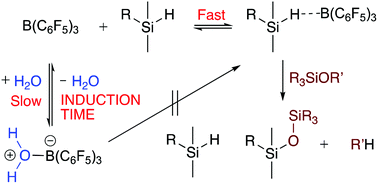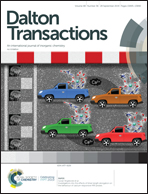Trace water affects tris(pentafluorophenyl)borane catalytic activity in the Piers–Rubinsztajn reaction†
Abstract
Improved methods to control silicone synthesis are required due to the sensitivity of siloxane bonds to acid/base-mediated chain redistribution/depolymerization. The Piers–Rubinsztajn reaction employs tris(pentafluorophenyl)borane as an efficient catalyst (<0.1 mol%) for siloxane bond formation from hydro- and alkoxysilanes – typical reactions proceed in open flasks at room temperature within minutes. While advantageous under ideal conditions, the boron catalyst activity may be affected by age, storage conditions and various environmental factors, particularly humidity. Under conditions of high humidity it may be necessary to apply heat and/or use increased catalyst loading in the reactions; there is often an induction time. We examine induction times in the Piers–Rubinsztajn reaction as a function of water concentrations in the reagent or catalyst solution and show that water in the reagent solution or atmosphere is less problematic than water found in the catalyst stock solution. A relatively linear increase in induction time accompanied higher water concentrations in the catalyst solution – no such effect was observed when the water was in the reagent solution. Reaction rates in both scenarios were similar, i.e., not affected by the induction time. Improvements in the stability of catalyst solutions were observed when B(C6F5)3 was stored in low molecular weight silicone oils, and pre-complexed with HSi(OSiMe3)3. These outcomes are ascribed to the ability of HSi groups to outcompete water in binding with B(C6F5)3 to initiate reaction, unless the boron is pre-complexed with water.



 Please wait while we load your content...
Please wait while we load your content...